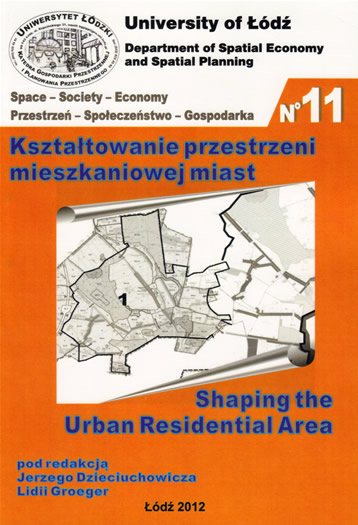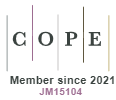WALORYZACJA I TYPOLOGIA PRZESTRZENNA ZASOBÓW MIESZKANIOWYCH ŁODZI W OKRESIE TRANSFORMACJI
DOI:
https://doi.org/10.18778/1733-3180.11.02Słowa kluczowe:
Spatial typology, residental area, ŁódźAbstrakt
Przedmiotem tego opracowania jest waloryzacja i typologia przestrzenna zasobów mieszkaniowych Łodzi w warunkach charakterystycznych dla okresu transformacji. Wielozmienna analiza tych zasobów obejmuje rozmieszczenie i intensywność zabudowy mieszkaniowej, jej dynamikę (w latach 1988–2002), wiek oraz formy własności, a także wielkość budynków i mieszkań, wyposażenie lokali mieszkalnych w instalacje sanitarno-techniczne oraz zaludnienie mieszkań. Określone cechy zasobów mieszkaniowych były rozpatrywane według stanu ustalonego w momencie krytycznym NSP z 2002 r., przy przyjęciu podziału miasta na 61 jednostek osiedlowych. W waloryzacji zasobów mieszkaniowych posłużono się zmienną syntetyczną będącą funkcją 13 cech diagnostycznych, stanowiących stymulanty standardu mieszkaniowego. Natomiast do opracowania typologii przestrzennej zasobów mieszkaniowych wykorzystano metodę K-średnich, zaliczaną do najbardziej efektywnych metod iteracyjno-optymalizacyjnych stosowanych w taksonomii numerycznej, posługując się zbiorem 19 cech typologicznych. Standard mieszkaniowy ma układ przestrzenny zbliżony do koncentryczno- -sektorowego, przy ogólnym wzroście tego standardu w kierunku odśrodkowym. Podobny układ stwierdzono w badaniach standardu mieszkaniowego jednostek urbanistycznych Łodzi w 1988 r., dowodząc tym samym, że okres transformacji nie doprowadził do zasadniczych, jakościowych przekształceń przestrzeni mieszkaniowej miasta. Zastosowanie metody K-średnich pozwoliło na wydzielenie siedmiu skupień, traktowanych jako odpowiedniki typów jednostek osiedlowych. Poszczególnym typom nadano następujące nazwy pochodzące od najbardziej wyróżniających cech ich zasobów mieszkaniowych: typ 1 – wysoka dynamika budownictwa mieszkaniowego, przy dużym udziale mieszkań spółdzielczych w zabudowie jednorodzinnej i wielorodzinnej; typ 2 – wysoki udział mieszkań należących do Skarbu Państwa i duże zaludnienie mieszkań w zabudowie jednorodzinnej z domieszką wielorodzinnej; typ 3 – silna dominacja zabudowy jednorodzinnej, przy niskim stopniu zaludnienia mieszkań i wysokim poziomie ich wyposażenia w instalacje sanitarno- -techniczne; typ 4 – dominacja zabudowy jednorodzinnej i zagrodowej, przy wysokim stopniu zaludnienia mieszkań i niskiej samodzielności użytkowania mieszkań przez gospodarstwa domowe; typ 5 – względna nadwyżka prywatnych mieszkań w przedwojennej zabudowie jednorodzinnej o niskim zaludnieniu; typ 6 – względna dominacja przedwojennych kamienic czynszowych, w połączeniu z wysokim udziałem mieszkań komunalnych; typ 7 – dominacja intensywnej zabudowy blokowej o bardzo dużych zasobach mieszkaniowych.
Pobrania
Bibliografia
Anderberg M. R., 1973, Cluster Analysis for Applications, Academic Press, New York.
Google Scholar
Bartosiewiczowa S., 1976, Ekonometria. Technologia ekonometrycznego przetwarzania danych, PWE, Warszawa.
Google Scholar
Dzieciuchowicz J., 1980, Kompleksowa rejonizacja warunków mieszkaniowych ludności wielkiego miasta (Przykład Łodzi), ”Acta Universitatis Lodziensis”,
Google Scholar
Zeszyty Naukowe UŁ, Nauki Matematyczno-Przyrodnicze, Seria II, z. 22.
Google Scholar
Dzieciuchowicz J., 2002, Zasoby mieszkaniowe Łodzi: rozwój, struktura przedmiotowa i przestrzenna, „Acta Universitatis Lodziensis. Folia Geographica”, z. 13.
Google Scholar
Dzieciuchowicz J., 2009, Przemiany ludnościowe Łodzi na przełomie XX i XXI wieku [w:] Liszewski S. (red.), Łódź. Monografia miasta, ŁTN, Łódź.
Google Scholar
Grabiński T., 1992, Metody taksonometrii, Akademia Ekonomiczna w Krakowie, Kraków.
Google Scholar
Grabiński T., Wydymus S., Zeliaś A., 1989, Metody taksonomii numerycznej w modelowaniu zjawisk społeczno-gospodarczych, PWN, Warszawa.
Google Scholar
Guilford J. P., 1960, Podstawowe metody statystyczne w psychologii i pedagogice, PWN, Warszawa.
Google Scholar
Kolenda M., 2006, Taksonomia numeryczna. Klasyfikacja, porządkowanie i analiza obiektów wielocechowych, Seria Monografie i Opracowania nr 170, Wyd. AE we Wrocławiu, Wrocław.
Google Scholar
Sparks D. N., 1973, Euclidean Luster Analysis. Algorithm AS58, “Applied Statistics”, t. 22.
Google Scholar
DOI: https://doi.org/10.2307/2346321
Pobrania
Opublikowane
Jak cytować
Numer
Dział
Licencja

Praca jest udostępniana na licencji Creative Commons Attribution-NonCommercial-NoDerivatives 3.0 Unported License.









